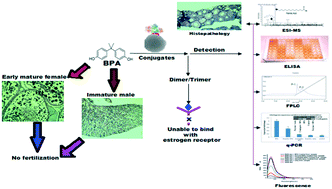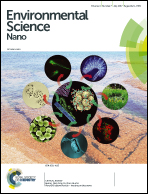Laccase–silica nanoparticle conjugates can efficiently reduce the early maturation risk due to BPA in female Oreochromis mossambicus and its toxic load from the contaminated effluent†
Abstract
Purified intracellular laccase from Trametes versicolor was conjugated with synthesized silica nanoparticles (200 nm). The data obtained from isothermal titration calorimetry (ITC) indicated that the exothermic nature of conjugation was stable due to moderate positive and negative values of entropy and enthalpy, respectively. The in silico approach (molecular docking) revealed that BPA can be attached to the laccase enzyme at a specific binding pocket, along with similar types of moderate thermodynamic parameters obtained from ITC. Histopathology and ESI-MS analysis clearly indicate that early maturation of the fingerling (Oreochromis mossambicus) ovary, along with the necrosis of hepatocytes and the BPA deposition in the liver can be significantly reduced by the immobilization of laccase on silica nanoparticles, compared to free laccase. A significant reduction of vitellogenin protein expression levels (an ovary maturation factor) in fingerling stages, due to immobilized laccase was determined using FPLC and ELISA. The decreasing vitellogenin gene expression level was also determined using q-PCR, which was correlated with the significant reduction of early maturation in the ovaries (fingerling stage) using laccase–nanoparticle conjugates. ESI-MS and fluorescence quenching assays using rhodamine-B were used to ascertain the effective reduction of BPA concentration from the industrial effluent.



 Please wait while we load your content...
Please wait while we load your content...